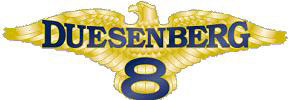
Delage was a French luxury automobile and racecar company founded in 1905 by Louis Delâge in Levallois-Perret near Paris; it was acquired by Delahaye in 1935 and ceased operation in 1953.

Maserati Ghibli is the name of three different cars produced by Italian automobile manufacturer Maserati: the AM115, a V8 grand tourer from 1967 to 1973; the AM336, a V6 twin-turbocharged coupé from 1992 to 1998; and the M157, an executive saloon from 2013 onwards.

The Ferrari 500 was a Formula 2 racing car designed by Aurelio Lampredi and used by Ferrari in 1952 and 1953, when the World Championship was run to F2 regulations.

The Fiat 518, also called Fiat Ardita, was a model of car produced by Italian car manufacturer Fiat between 1933 and 1938. The name "Ardita" was also used on the six-cylinder engined and more expensive Fiat Ardita 2500 or 527.
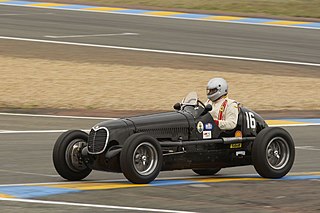
The Maserati 6CM is an Italian single-seater racing car, made by Maserati of Modena from 1936 to 1940 for the Voiturette racing class. Twenty-seven were built on the Maserati 4CM frame, with front suspension as on the Maserati V8RI, and had a successful racing career from 1936 to 1939. The 6CM was introduced to the world at the 1936 Milan Motor Show. Maserati spent much of its early years manufacturing cars for privateers in the racing field. The Maserati 6CM is no exception.

The Maserati 4CL and its derived sister model the Maserati 4CLT are single-seat open-wheel Grand Prix racing cars that were designed and built by Maserati. The 4CL was introduced at the beginning of the 1939 season, as a rival to the Alfa Romeo 158 and various ERA models in the voiturette class of international Grand Prix motor racing. Although racing ceased during World War II, the 4CL was one of the front running models at the resumption of racing in the late 1940s. Experiments with two-stage supercharging and tubular chassis construction eventually led to the introduction of the revised 4CLT model in 1948. The 4CLT was steadily upgraded and updated over the following two years, resulting in the ultimate 4CLT/50 model, introduced for the inaugural year of the Formula One World Championship in 1950. In the immediate post-war period, and the first two years of the Formula One category, the 4CLT was the car of choice for many privateer entrants, leading to numerous examples being involved in most races during this period.

The Maserati A6GCM is a single seater racing car from the Italian manufacturer Maserati. Developed for Formula Two, 12 cars were built between 1951 and 1953.

The Alfa Romeo Tipo 308 or 8C-308 is a Grand Prix racing car made for the 3 litre class in 1938. Only four cars were produced, actually modified from Tipo C with the engine mounted lower into the chassis and a slimmer body. The chassis was derived from the Tipo C and the engine from the 8C 2900. The 308 was engineered by Gioacchino Colombo under the control of Enzo Ferrari who was then in charge of Alfa's racing team, Alfa Corse. The car debuted at the Pau Grand Prix in 1938, where two cars were entered to race, one for Tazio Nuvolari and the other for Luigi Villoresi. Both drivers had to withdraw from competition, however Nuvolari had by then set a lap record. The next race was the Tripoli Grand Prix. The new 312 and 316 were entered, but they had engine trouble during practice and Clemente Biondetti took the start at the wheel of the 308 held in reserve. He failed to finish, while Hermann Lang, driving a Mercedes-Benz W154, was the winner. In this race, Eugenio Siena, driving a 312, was killed after hitting a wall.
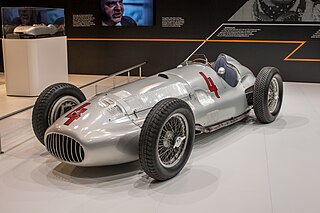
The Mercedes-Benz W154 was a Grand Prix racing car designed by Rudolf Uhlenhaut. The W154 competed in the 1938 and 1939 Grand Prix seasons and was used by Rudolf Caracciola to win the 1938 European Championship.
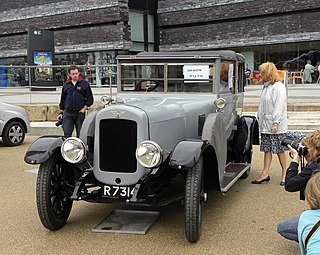
Austin Twenty is a large car introduced by Austin after the end of the First World War, in April 1919 and continued in production until 1930. After the Austin 20/6 model was introduced in 1927, the first model was referred to as the Austin 20/4.

The Maserati 250S, and its derivative and version, the 250 Sport, are sports racing cars, designed, developed and built by Italian car manufacturer Maserati, between 1954 and 1957. Only two models were produced.
The Audi R8 LMS Cup was a one-make sports car racing series by Audi based in Asia. Audi R8 LMS Cup cars were based on the Audi R8 LMS (GT3).

The 1921 S.T.D. 'Works' Grand Prix chassis was built to the three-litre and minimum weight of 800 kilogrammes formula for that year's Indianapolis 500 and French Grand Prix de l’A.C.F. These team cars were modified by the Sunbeam Experimental department in Wolverhampton for the 1922 Isle of Man Tourist Trophy, which was won by one of the cars. A few months later, and with 1916 4.9-litre engines, two of the T.T. cars competed in the Coppa Florio, Sicily and gained second and fourth position.

The Maserati 150 GT was a prototype sports car produced by Maserati in 1957. Derived from the four-cylinder Maserati 150S race car, it was a singular road-going example, and was given spyder bodywork.

The Maserati 420M/58Eldorado was a single-seater manufactured by Maserati in 1958. It was a one-off race car purpose-built for the second edition of the 500 Miles of Monza. It was the first single-seater in Europe to be sponsored by a brand not attached to an automobile industry. The internal Maserati classification was the Tipo 4, behind the 250F variants, and also referred to as the 420/M/58 for 4.2-litre displacement, Monoposto or a single-seater in Italian and 1958 year, or simply as the "Eldorado".

The Ferrari 166 FL was a single-seat open-wheel race car, designed, developed and built by Italian manufacturer and team, Scuderia Ferrari, 1949 to 1952. Only three cars were produced. The designation 166 refers to the (rounded) displacement of a single cylinder, which corresponded to the nomenclature of the company at the time. The abbreviation FL stands for Formula Libre, which is the type of category and racing series that the car competed in. Since the car was mainly developed for racing in South America, it was also known as the 166 C America.
The Maserati 8CL is an open-wheel Grand Prix motor racing car, designed, developed and built by Italian manufacturer Maserati, from 1940 through 1946. Only two models were produced.
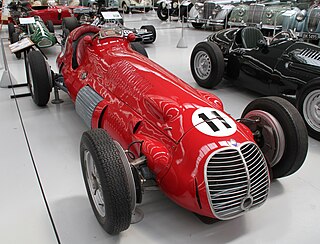
The Maserati 8CLT is an open-wheel race car, designed, developed and built by Italian manufacturer Maserati in 1950, conforming to Formula One rules and regulations of the time, set by the FIA.

The Maserati 6C 34 is a 750 kg open-wheel Grand Prix race car, designed, developed and built by Maserati from 1934 to 1935.



